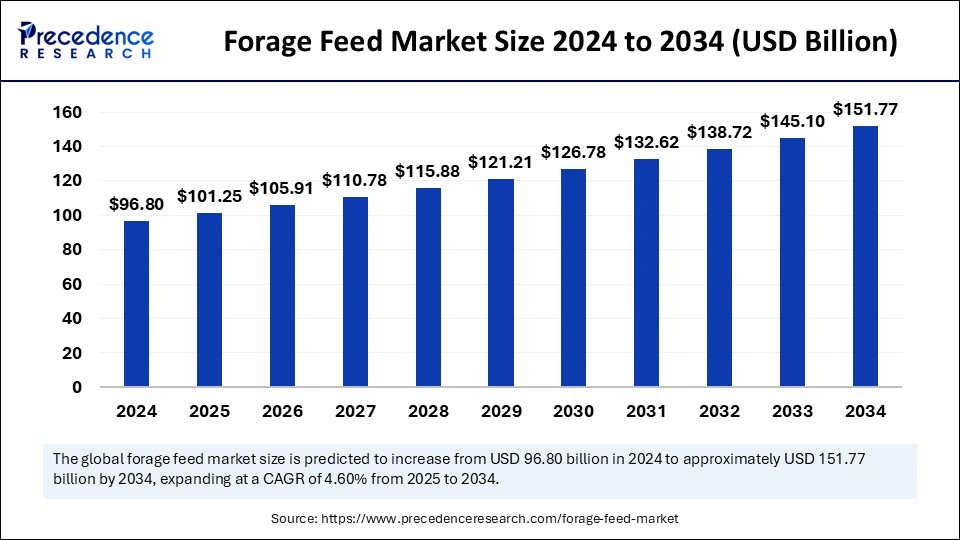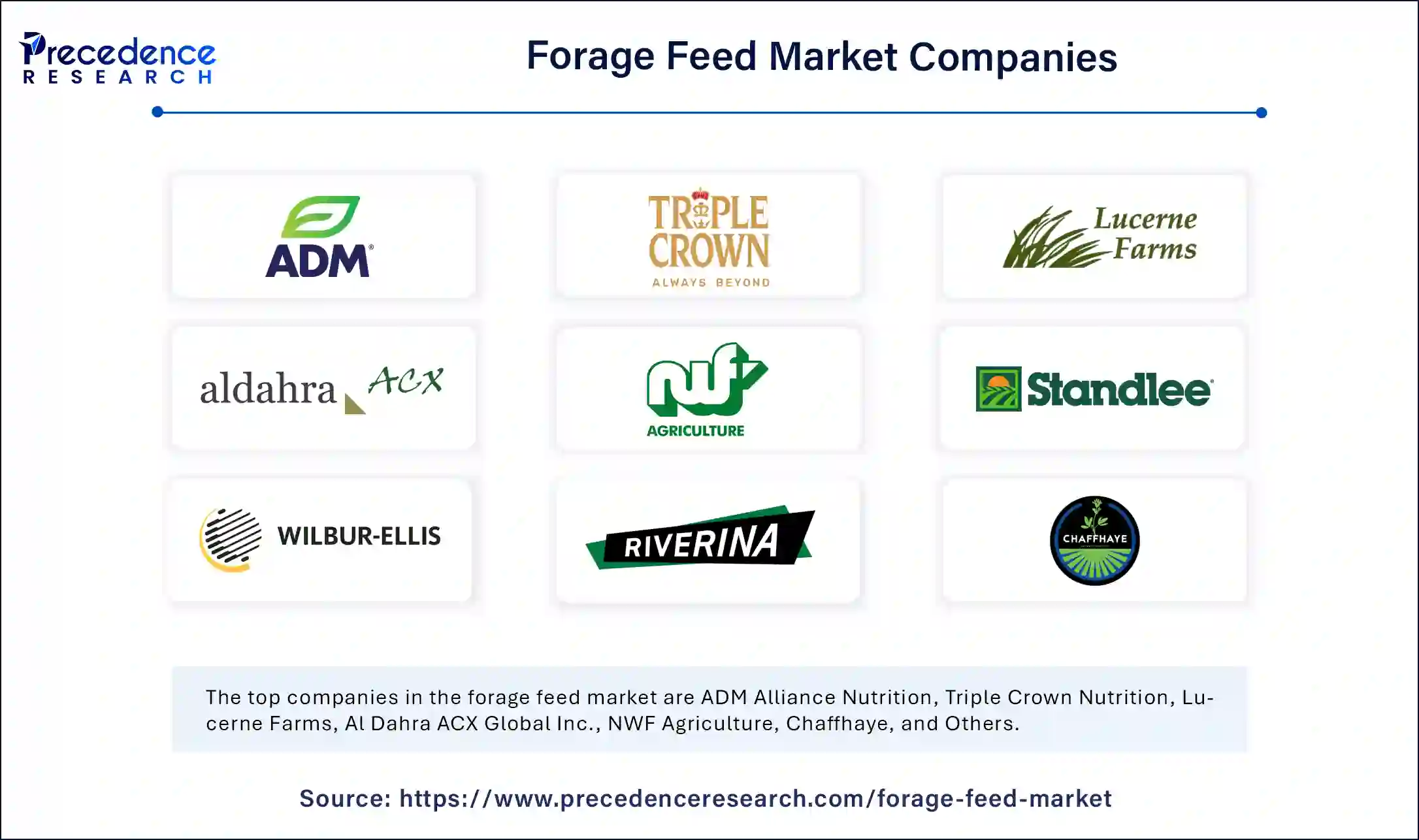Forage Feed Market Size to Hit USD 151.77 Bn by 2034
Forage Feed Market Size and Forecast 2025 to 2034
The global forage feed market size surpassed USD 96.80 billion in 2024 and is projected to hit around USD 151.77 billion by 2034 with a CAGR 4.60% from 2025 to 2034.

Get a Free Sample Copy of the Report@ https://www.precedenceresearch.com/sample/5774
Forage Feed Market Key Highlights
-
In 2024, North America dominated the forage feed market with the largest share.
-
Asia Pacific is expected to be the fastest-growing region in the coming years.
-
Among products, stored forage led the market with the highest share in 2024.
-
The fresh forage segment is set to experience remarkable growth in the forecast period.
-
The ruminants segment contributed the largest portion of the market share in 2024.
-
The poultry segment is anticipated to expand rapidly in the near future.
How AI is Transforming the Forage Feed Market for Smarter Farming
AI is playing a transformative role in the forage feed market by optimizing farming practices, improving livestock nutrition, and enhancing supply chain efficiency. AI-powered predictive analytics enable farmers to assess soil quality, weather conditions, and crop health, allowing them to make data-driven decisions on forage cultivation.
Machine learning algorithms analyze past yield patterns and recommend the best harvesting times, ensuring maximum nutritional value in forage feed. Additionally, AI-integrated drones and sensors monitor field conditions in real time, detecting pests, diseases, and nutrient deficiencies, thereby reducing wastage and improving overall crop productivity.
AI also plays a crucial role in livestock management by analyzing feeding patterns, tracking animal health, and optimizing diets based on real-time data. Smart feeding systems use AI to balance forage nutrients, ensuring livestock receive optimal nutrition for growth and productivity.
In the supply chain, AI-driven logistics and inventory management systems help producers and distributors optimize storage, reduce spoilage, and forecast demand accurately. As AI technology advances, its integration into the forage feed market is expected to enhance efficiency, sustainability, and profitability for farmers and industry stakeholders.
Growth Factors for the Forage Feed Market
-
Rising Demand for High-Quality Animal Nutrition
The increasing awareness about livestock health and productivity is driving demand for high-quality forage feed. Farmers are focusing on nutrient-rich forage to enhance milk and meat production, improving overall efficiency in the livestock sector. -
Expanding Livestock Industry
The growing global population and rising consumption of animal-based products, such as dairy, meat, and poultry, are boosting the need for efficient livestock feeding solutions. This directly contributes to the expansion of the forage feed market. -
Technological Advancements in Forage Processing
Innovations in forage preservation techniques, such as silage inoculants and hay conditioning, are improving the shelf life and nutritional value of forage feed, making it more efficient for livestock farming. -
Government Support and Subsidies
Many governments are promoting sustainable livestock farming through financial incentives and subsidies, encouraging farmers to invest in high-quality forage feed for improved animal health and productivity. -
Increasing Adoption of Precision Farming
The use of AI, IoT, and precision farming techniques is optimizing forage cultivation, reducing wastage, and enhancing yield quality, which is propelling the growth of the forage feed market. -
Rising Demand for Organic and Natural Feed
The shift towards organic and chemical-free livestock products has led to an increased preference for natural forage feed, driving demand in both developed and emerging markets. -
Climate Change and Its Impact on Grazing Land
As climate change affects natural grazing lands, farmers are relying more on stored and processed forage feed to maintain consistent livestock nutrition throughout the year. -
Growth in Dairy and Meat Processing Industries
The expansion of the dairy and meat processing sectors is fueling the demand for quality forage feed to ensure consistent milk production and healthier livestock for meat processing. -
Increasing Awareness About Sustainable Agriculture
Sustainable livestock feeding practices, including rotational grazing and improved forage management, are being adopted to minimize environmental impact, further driving the forage feed market. -
Global Trade and Export Opportunities
The rising export of forage feed, particularly from countries with advanced agricultural practices, is expanding market opportunities and fostering global growth in the industry.
Forage Feed: An Overview
What is Forage Feed?
Forage feed refers to plant-based feed primarily used for livestock nutrition. It includes fresh or stored plant material such as grass, legumes, hay, and silage that provide essential nutrients to ruminants like cattle, sheep, and goats. Forage is a crucial component of animal diets, supplying fiber, protein, and energy while promoting digestion and overall health.
Types of Forage Feed
-
Fresh forage – Includes pasture grass, clover, and other green crops consumed directly by animals.
-
Stored forage – Includes hay (dried grass), silage (fermented forage), and haylage (semi-dried forage wrapped for preservation).
-
Crop residues – After-harvest remains of crops like wheat straw, maize stalks, and rice husks.
-
Specialty forages – High-protein forage crops like alfalfa and legumes are used for enhanced nutrition.
Importance of Forage Feed in Livestock Farming
-
Nutritional benefits: Provides essential nutrients such as fiber, protein, and vitamins for animal growth and milk/meat production.
-
Cost-effective: More affordable than processed animal feed, making it a sustainable option for farmers.
-
Environmental sustainability: Helps reduce reliance on grain-based feed, promoting eco-friendly livestock farming.
-
Improves animal digestion: High-fiber content supports digestive health in ruminants.
Factors Influencing Forage Feed Production
-
Climate and soil conditions: Temperature, rainfall, and soil fertility affect forage crop yields.
-
Agricultural practices: Irrigation, fertilization, and crop rotation impact forage quality and availability.
-
Livestock demand: Growing demand for dairy and meat products increases forage feed consumption.
-
Technology and innovations: AI-driven precision farming and improved storage techniques enhance efficiency.
Global Forage Feed Market Trends
-
Rising adoption of organic and non-GMO forage feed for sustainable livestock farming.
-
Increased focus on climate-resilient forage crops to counter changing weather conditions.
-
Expansion of precision agriculture technologies to optimize forage production.
-
Growing government initiatives and subsidies to support livestock farmers.
Key Forage Feed Producing Regions
-
North America: Advanced livestock farming practices and high demand for dairy and meat.
-
Asia Pacific: Rapidly growing meat and dairy consumption, especially in China and India.
-
Europe: Strong preference for organic and high-quality feed options.
-
Latin America and Africa: Emerging markets with increasing investments in sustainable animal farming.
Market Scope
| Report Coverage | Details |
| Market Size by 2034 | USD 151.77 Billion |
| Market Size in 2025 | USD 101.25 Billion |
| Market Size in 2024 | USD 96.80 Billion |
| Market Growth Rate from 2025 to 2034 | CAGR of 4.60% |
| Dominated Region | North America |
| Fastest Growing Market | Asia Pacific |
| Base Year | 2024 |
| Forecast Period | 2025 to 2034 |
| Segments Covered | Products, animal type, and Regions |
| Regions Covered | America, Europe, Asia-Pacific, Latin America and Middle East & Africa |
Market Dynamics
Market Drivers Fueling Growth
One of the main drivers of the forage feed market is the increasing demand for dairy and meat products. As global populations grow and dietary preferences shift, livestock production is on the rise, leading to higher forage feed consumption. Additionally, the adoption of precision farming and smart feeding systems is enhancing the efficiency of forage utilization.
Emerging Market Opportunities
Opportunities in the forage feed market lie in the development of climate-resistant forage crops and innovative feed processing methods. The rising demand for organic and sustainably sourced feed is pushing companies to invest in alternative forage options. Furthermore, partnerships between feed manufacturers and livestock farmers are fostering innovations in customized feed solutions.
Industry Challenges
Challenges in the forage feed industry include climate change impacts, which can lead to inconsistent crop yields and supply shortages. Additionally, increasing costs of feed production and storage may hinder market accessibility for small-scale farmers. Strict regulations regarding feed quality and additives also pose challenges for market players.
Regional Growth Trends
North America remains the dominant market for forage feed, with strong demand from the dairy and meat industries. Asia Pacific is expected to grow at the fastest rate due to rising livestock farming and increased investments in agriculture. Europe is witnessing stable growth, with a focus on high-quality feed production. Latin America and Africa are gradually expanding their livestock industries, presenting new market opportunities.
Forage Feed Market Companies

- ADM Alliance Nutrition
- Triple Crown Nutrition
- Lucerne Farms
- Al Dahra ACX Global Inc.
- NWF Agriculture
- Standlee Premium Products, LLC
- Wilbur-Ellis Holdings Inc.
- Riverina Australia Pty Ltd.
- Chaffhaye
- Baileys Horse Feeds
Recent Developments
- In October 2024, Renovo Seed declared the addition of a new forage mix, OptiHarv. The mix includes several types of millets, peas, beans, barley, and brassicas to yield considerable amounts of baleage, haylage, and grazing matériel.
- In March 2023, PGG Wrightson Seeds announced the GT07 phalaris variety. Consumers value GT07 for its development through CSIRO’s breeding program because it demonstrates PGG Wrightson Seeds’ dedication to agricultural innovation and sustainability.
- In September 2023, MAS Seeds revealed a new forage mixture collection and specialized blends; they introduced their “MAS4 NUTRI” forage containing high levels of legumes for animal nutrition enhancement. The new launches come as a part of the company’s efforts to raise its agronomic offerings to farmers.
Segments Covered in the Report
By products
- Stored Forage
- Fresh Forage
- Other Products
By animal type
- Ruminants
- Poultry
- Swine
- Others
By region
- North America
- Asia Pacific
- Europe
- Latin America
Also Read: Polymer 3D Printing Market
Ready for more? Dive into the full experience on our website@ https://www.precedenceresearch.com/
